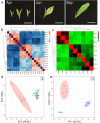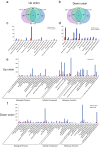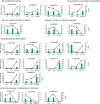Integrated transcriptomics and metabolomics analysis of catechins, caffeine and theanine biosynthesis in tea plant (Camellia sinensis) over the course of seasons
- PMID: 32600265
- PMCID: PMC7322862
- DOI: 10.1186/s12870-020-02443-y
Integrated transcriptomics and metabolomics analysis of catechins, caffeine and theanine biosynthesis in tea plant (Camellia sinensis) over the course of seasons
Abstract
Background: Catechins, caffeine, and theanine as three important metabolites in the tea leaves play essential roles in the formation of specific taste and shows potential health benefits to humans. However, the knowledge on the dynamic changes of these metabolites content over seasons, as well as the candidate regulatory factors, remains largely undetermined.
Results: An integrated transcriptomic and metabolomic approach was used to analyze the dynamic changes of three mainly metabolites including catechins, caffeine, and theanine, and to explore the potential influencing factors associated with these dynamic changes over the course of seasons. We found that the catechins abundance was higher in Summer than that in Spring and Autumn, and the theanine abundance was significantly higher in Spring than that in Summer and Autumn, whereas caffeine exhibited no significant changes over three seasons. Transcriptomics analysis suggested that genes in photosynthesis pathway were significantly down-regulated which might in linkage to the formation of different phenotypes and metabolites content in the tea leaves of varied seasons. Fifty-six copies of nine genes in catechins biosynthesis, 30 copies of 10 genes in caffeine biosynthesis, and 12 copies of six genes in theanine biosynthesis were detected. The correlative analysis further presented that eight genes can be regulated by transcription factors, and highly correlated with the changes of metabolites abundance in tea-leaves.
Conclusion: Sunshine intensity as a key factor can affect photosynthesis of tea plants, further affect the expression of major Transcription factors (TFs) and structural genes in, and finally resulted in the various amounts of catechins, caffeine and theaine in tea-leaves over three seasons. These findings provide new insights into abundance and influencing factors of metabolites of tea in different seasons, and further our understanding in the formation of flavor, nutrition and medicinal function.
Keywords: Caffeine; Catechins; Metabolomics; Seasons; Theanine; Transcriptomics.
Conflict of interest statement
The authors declare that they have no competing interests.
Figures







Similar articles
-
Comparative Transcriptomic Analysis Reveals Regulatory Mechanisms of Theanine Synthesis in Tea (Camellia sinensis) and Oil Tea (Camellia oleifera) Plants.J Agric Food Chem. 2019 Sep 11;67(36):10235-10244. doi: 10.1021/acs.jafc.9b02295. Epub 2019 Aug 30. J Agric Food Chem. 2019. PMID: 31436988
-
Global transcriptome and gene regulation network for secondary metabolite biosynthesis of tea plant (Camellia sinensis).BMC Genomics. 2015 Jul 29;16(1):560. doi: 10.1186/s12864-015-1773-0. BMC Genomics. 2015. PMID: 26220550 Free PMC article.
-
Transcriptomic and phytochemical analysis of the biosynthesis of characteristic constituents in tea (Camellia sinensis) compared with oil tea (Camellia oleifera).BMC Plant Biol. 2015 Aug 7;15:190. doi: 10.1186/s12870-015-0574-6. BMC Plant Biol. 2015. PMID: 26245644 Free PMC article.
-
Exploring plant metabolic genomics: chemical diversity, metabolic complexity in the biosynthesis and transport of specialized metabolites with the tea plant as a model.Crit Rev Biotechnol. 2020 Aug;40(5):667-688. doi: 10.1080/07388551.2020.1752617. Epub 2020 Apr 22. Crit Rev Biotechnol. 2020. PMID: 32321331 Review.
-
Regulation of biosynthesis of the main flavor-contributing metabolites in tea plant (Camellia sinensis): A review.Crit Rev Food Sci Nutr. 2023;63(30):10520-10535. doi: 10.1080/10408398.2022.2078787. Epub 2022 May 24. Crit Rev Food Sci Nutr. 2023. PMID: 35608014 Review.
Cited by
-
Promoting L-theanine accumulation in Camellia sinensis through irrigation with Pseudomonas knackmussii.Plant Cell Rep. 2025 Jul 14;44(8):175. doi: 10.1007/s00299-025-03556-0. Plant Cell Rep. 2025. PMID: 40658255
-
Tonoplast-Localized Theanine Transporter CsCAT2 May Mediate Theanine Storage in the Root of Tea Plants (Camellia sinensis L.).Front Plant Sci. 2021 Dec 17;12:797854. doi: 10.3389/fpls.2021.797854. eCollection 2021. Front Plant Sci. 2021. PMID: 34975988 Free PMC article.
-
Influence of Primary Light Exposure on the Morphophysiological Characteristics and Phenolic Compounds Accumulation of a Tea Callus Culture (Camellia sinensis L.).Int J Mol Sci. 2024 Sep 27;25(19):10420. doi: 10.3390/ijms251910420. Int J Mol Sci. 2024. PMID: 39408751 Free PMC article.
-
L-Theanine: A Unique Functional Amino Acid in Tea (Camellia sinensis L.) With Multiple Health Benefits and Food Applications.Front Nutr. 2022 Apr 4;9:853846. doi: 10.3389/fnut.2022.853846. eCollection 2022. Front Nutr. 2022. PMID: 35445053 Free PMC article. Review.
-
Combined analysis of transcriptomics and metabolomics revealed complex metabolic genes for diterpenoids biosynthesis in different organs of Anoectochilus roxburghii.Chin Herb Med. 2022 Nov 21;15(2):298-309. doi: 10.1016/j.chmed.2022.11.002. eCollection 2023 Apr. Chin Herb Med. 2022. PMID: 37265764 Free PMC article.
References
-
- Zhu B, Chen LB, Lu M, Zhang J, Han J, Deng WW, Zhang ZZ. Caffeine Content and Related Gene Expression: Novel insight into caffeine metabolism in Camellia plants containing low, normal, and high caffeine concentrations. J Agric Food Chem. 2019;67(12):3400–3411. doi: 10.1021/acs.jafc.9b00240. - DOI - PubMed
-
- Xia EH, Zhang HB, Sheng J, Li K, Zhang QJ, Kim C, Zhang Y, Liu Y, Zhu T, Li W, Huang H, Tong Y, Nan H, Shi C, Jiang JJ, Mao SY, Jiao JY, Zhang D, Zhao YJ, Zhang LP, Liu YL, Liu BY, Yu Y, Shao SF, Ni DJ, Eichler EE, Gao LZ. The tea tree genome provides insights into tea flavor and independent evolution of caffeine biosynthesis. Mol Plant. 2017;10(6):866–877. doi: 10.1016/j.molp.2017.04.002. - DOI - PubMed
MeSH terms
Substances
Grants and funding
LinkOut - more resources
Full Text Sources
Medical

